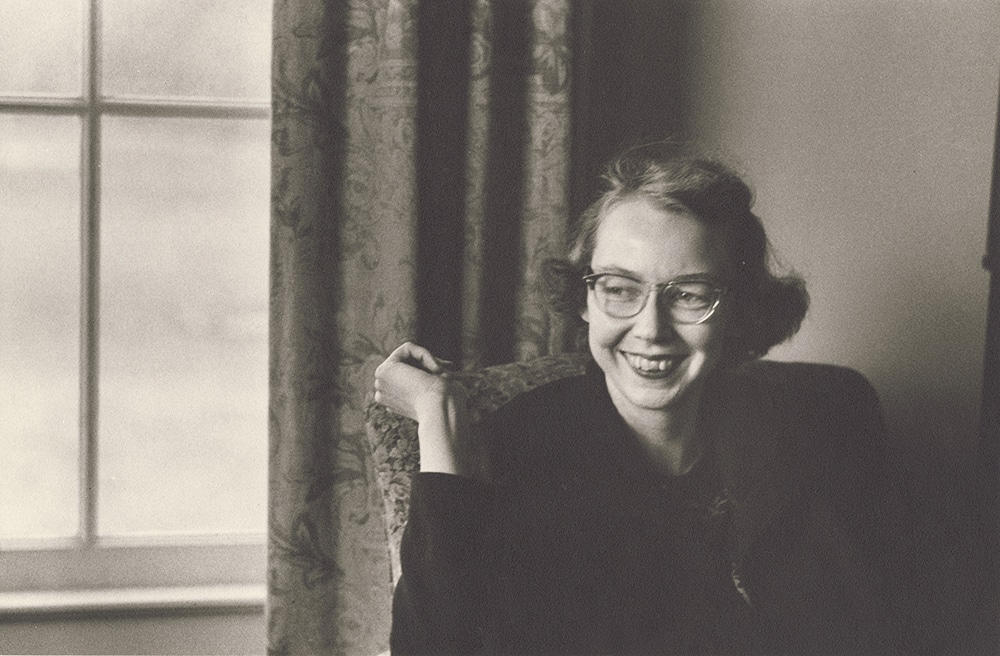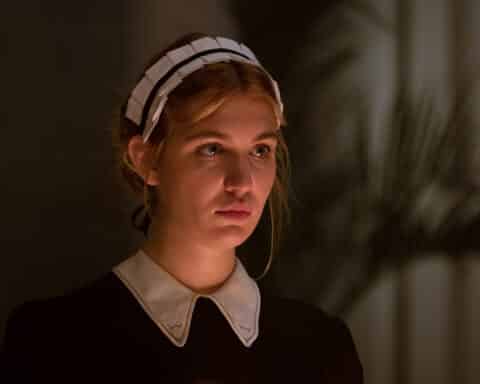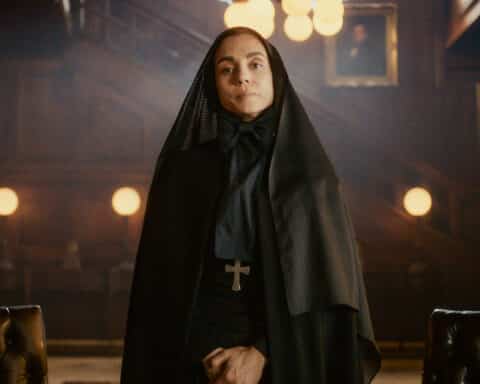“Flannery,” a film from Long Distance Productions in association with American Masters by Elizabeth Coffman and Mark Bosco, S.J., is a notable presentation about the American Catholic author Flannery O’Connor, her life and work. And to begin with, we must acknowledge that such a gathering is needed, if only because of the challenge of comprehending the work and the person of the author. There is a sense in which the work is less challenging than is the profile of the author, and therefore some have reduced the work to the idiosyncrasies of that author. When we consider the results, we are most likely to be quite favorably impressed by this account of the life of the author, and the circumstantial production of the familiar stories, novels, essays and letters.
We also experience here the sorts of classification that are perhaps less productive of insight than they might seem to be. To take on Flannery O’Connor as a female author is less enlightening than it assertively presumes. To take her on as a Southerner is pretty much the same, but to approach her as a Christian or Catholic tells more. And strangely enough, perhaps to think of her as a writer of thrilling and shocking material in an age of literary violence tells even more. She was quite familiar, for example, with Nathanael West’s “Miss Lonelyhearts,” as readers of O’Connor’s first novel, “Wise Blood,” will recognize. She was a reader of extensive grasp and was accomplished in that regard. She did not flinch from such authorial stances as playing with the name of Martin Heidegger, as is perceptible in “Good Country People,” perhaps the most outrageous of her stories. There the word “legal” floats by, hinting that the protagonist Hulga, in her obsession, is “all leg.” That proposition seems relatively easy, compared to the use of Heidegger’s withheld name as a signal for “egg-hider” or “hide-egger.” That’s how far O’Connor was willing to go when she was on a roll. My point here is that such wordplay is neither inherently female, nor Southern.
My parents were friends of Flannery O’Connor, so that I knew who she was, and she knew me. Their friendship was based on certain Wednesday evenings, when some people from the Georgia State College for Women and some psychologists from the State Hospital were invited to literary discussions at O’Connor’s home, Andalusia.
Why were these gatherings instituted? I believe that Flannery wanted to arrange a service to the community beyond her writing, and in the sense that writers are readers, the service was well conceived. My father particularly enjoyed this aspect, as he was particularly well read — as was my mother, who was no slouch in this regard. One legend of these meetings was to identify the play, as I think it was, that one of the visitors brought to a meeting — a work that was provocative and even vulgar, and a work that annoyed and embarrassed Flannery, for giving the malicious prankster an occasion to invert the values of the gatherings. That was too bad, and I never did find out the details — but the sheer perversity would have suited an O’Connor story, however unsuitable it was to an O’Connor evening.
I once ran into Miss O’Connor in the domed Palladian mansion of the Georgia State College for Women — the Cline mansion was next door. But my slight acquaintance never grew, partly because I had to go away to college in 1962, and by the summer of 1964 she left this world — though she left a lot behind. Her funeral was the smallest one I have ever seen — that puzzled me. Later on, I discovered that my enduring commitment to O’Connor’s stories was an academic gift or opportunity, and I took advantage of that, until I found myself confronted with the 2,000 pages of drafts for “Wise Blood.” These inchoate pages were more or less an incomprehensible mess, and although I attempted to understand them, I could barely do so. The chaotic pages were a startling picture of the young author’s disorganized experiments, which was unfamiliar or even shocking to anyone used to O’Connor’s polished work.
But to return, there is an impressive display of various personal, familial and academic authorities in the film “Flannery,” and I would suggest that the late Sally Fitzgerald is the most personally informed of these. She had actually lived with O’Connor, and was subsequently responsible for the gathering of O’Connor’s letters into the volume entitled “The Habit of Being.” And there are many who sense that O’Connor’s best writing is in those letters. I have myself noticed this phenomenon in the case of other writers — Raymond Chandler, for instance. Though his writing as crime fiction was a success, he was even better when he was off-duty and freely addressing various topics. But this truth also reminds us that there are a number of convincing witnesses who testify about O’Connor. Professor Marshall Bruce Gentry, who teaches at O’Connor’s alma mater, is one of these; and the Florencourt sisters, cousins of O’Connor, are two more. “Flannery” is quite well endowed with such witnesses.
“Flannery” is therefore a convincing and satisfying suite of testimonies to both the writing and the person behind the writing. There is nothing in “Flannery” that is wrong or misleading — quite the opposite. For those who want to find out about the person behind the stories, “Flannery” is just the thing.
James O. Tate, Jr., was Professor of English at Dowling College on Long Island.





